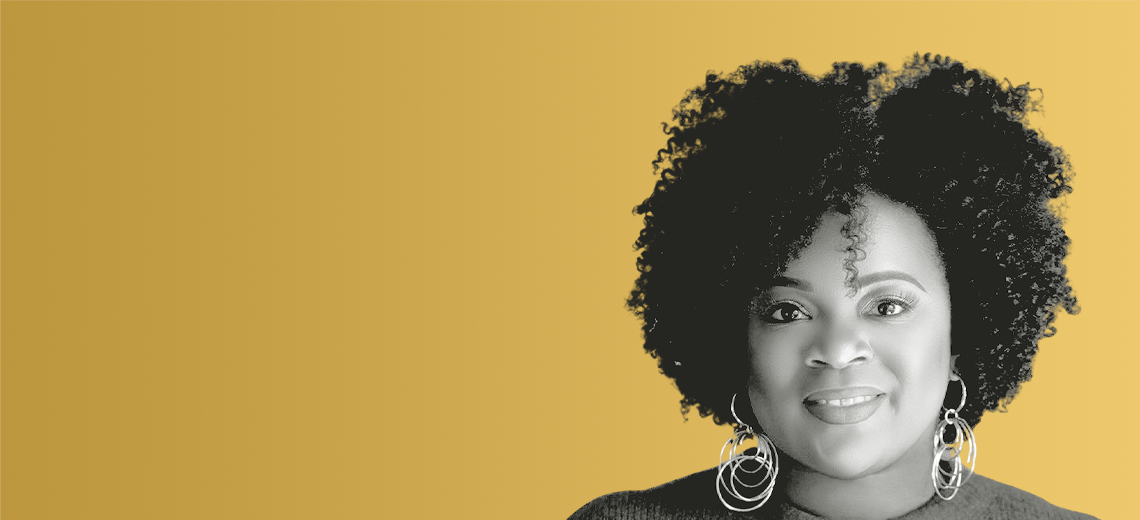This is an episode of the Glossy Beauty Podcast, which features candid conversations about how today’s trends are shaping the future of the beauty and wellness industries. More from the series →
Subscribe: Apple Podcasts | Stitcher | Google | Spotify
For Julian Addo, founder and CEO of textured hair-care brand Adwoa Beauty, her business is deeply intertwined with her own life story.
Addo was born in Monrovia, Liberia to a Ghanaian father and Liberian mother and moved to the U.S. in 1982. She worked in a beauty salon as a stylist and then as a salon owner. After a period in banking, while still doubling as a salon owner, Addo began to see how the DTC space was disrupting not only business models, but also branding itself. Inspired by the likes of Glossier and Warby Parker, Addo saw a stark lack of such branding innovation in the natural and textured hair sector. She said she woke up one day in March 2016 determined to develop Adwoa Beauty, which shares Addo’s traditional Ghanian name meaning “female born on a Monday.”
“I knew that I had to pull from my life and my experiences and my vision super heavily so that I could enjoy the brand, because it came from a passionate place,” Addo shared on this week’s episode of the Glossy Beauty Podcast.
Adwoa Beauty has been a Sephora-exclusive brand since Nov. 2019 and has 11 products. It plans to expand to an additional 158 doors in the first half of 2022, to a total of 448 U.S. Sephora doors. Adwoa Beauty is also in 48 Sephora Canada doors and will expand to all 98 locations. Approximately 65% of Adwoa Beauty sales are from Sephora, and Adwoa grew its Sephora sales 200% year-over-year between 2021 and 2020.
“For me, it’s about being smart on where we go and how we move. We want to grow but not grow too fast, because there are a lot of pain points that come with just spreading yourself too thin,” said Addo. “I never really saw Adwoa Beauty as a type of brand that was in 100,000 doors. I want this brand to provide its audience with an experience they hadn’t had before.”
Below are excerpts from the podcast, which have been lightly edited and condensed for clarity.
Ad position: web_incontent_pos1
On taking the leap to launch a brand
“I feel like it was my calling. I joined the natural hair community in 2012, and I chopped off my relaxed hair to go natural because I saw all of this action [around natural textured hair] happening on YouTube and Instagram. That reinvigorated the passion in me to get back into beauty. It felt more substantial than just being a stylist. I created a blog called Bella Kinks [and] started working with brands and influencers. As great as the [natural hair] industry was, we were so underground. I entered beauty in 1994, and products [stayed] the exact same. But Glossier launched, and Casper and Warby Parker, and everything was being repackaged, rebranded and remarketed, and it was new again. And I wasn’t seeing what was happening with other brands happening in the Black-owned and natural hair brand space.”
Being a Sephora-exclusive brand
“What drew me to Sephora was it was such an honest conversation. I said, ‘I don’t want to create 50,000 SKUs. I don’t want to create a new collection every six months. I don’t want to do this. I don’t want to do that.’ And they said they did not want me to do that, as well. It was the first time someone validated my pain points of what I saw in the industry and said, ‘We want you to just be you, and we want to amplify that.’… I know business is business, and everything I read says you go where the customers are. Making sure our distribution is super lean and being smart about how we grow supersedes the need to grow fast. So for right now, we’re exclusively at Sephora.”
Why the brand is self-funded
“To be honest, it wasn’t a decision; I couldn’t get funding. We made $1 million just on my website in the first year. I thought, ‘Holy cow, I could do this.’ And I went to the bank to get [a loan], and they gave me some automated decline. When we were going into Sephora, we tried to get money because of our purchase orders and still couldn’t get any money. There’s always a different excuse, like we don’t have any prior receivables or we’re still too small. Now, we’re in a position where we can fundraise. But once you see your [financial] potential [as a brand], you think, ‘Maybe I could do this on my own.’ Will I need a fundraise at some point? Yes, maybe. I’m not opposed to it. But for right now, let me see how far I can push [the business] before I have to fundraise.”




